Science & Health
CDC Finds Youth Marijuana Use Fell In Washington State’s Largest County After Adult-Use Legalization
Marijuana use among teens in Washington State’s most populous county declined after legalization of cannabis for adults, according to a new federal study published on Thursday by the Centers for Disease Control and Prevention (CDC). The prevalence of current and frequent use fell significantly among youth in grades 8, 10 and 12 between 2008 and 2021.
According to the study, published in CDC’s latest Morbidity and Mortality Weekly Report, current and frequent use of marijuana among teens in King County has fallen significantly since state voters legalized adult-use cannabis by initiative in November 2012.
Researchers said legalization and related regulations and age controls could have have fueled the trend by making marijuana harder for teens to access, though they also said the COVID pandemic may have contributed to more recent declines.
Between 2008 and 2021, current use—defined as having used marijuana at least once in the past month—fell from highs of 20.4 percent among males (in 2010) and 15.5 percent among females (in 2012) down to 7.7 percent and 9.0 percent, respectively, in 2021.
“The legalization of nonmedical cannabis for adults aged ≥21 years in Washington with licensed dispensaries requiring proof of age might have affected availability of cannabis to younger persons as well as their opportunities to engage in its use,” the CDC report says. “This, in turn, might have had an impact on use prevalence.”
“In 2012, Washington was among the first states to legalize nonmedical cannabis use for adults aged ≥21 years, prompting concern about how this measure might affect use by younger persons. Multiple factors might lead to increased cannabis use by youths, including increased permissiveness, reduced perception of potential harm, and an increase in alternative consumption methods (e.g., edibles and vaping). Despite these concerns, however, data from Washington suggest that legalization was not associated with increased cannabis use by adolescents and young adults.”
Researchers drew data from Washington’s Healthy Youth Survey, administered to public school students by the state’s Department of Health. In addition to analyzing current use, they also examined “frequent use,” referring to use on six or more days within the past month.
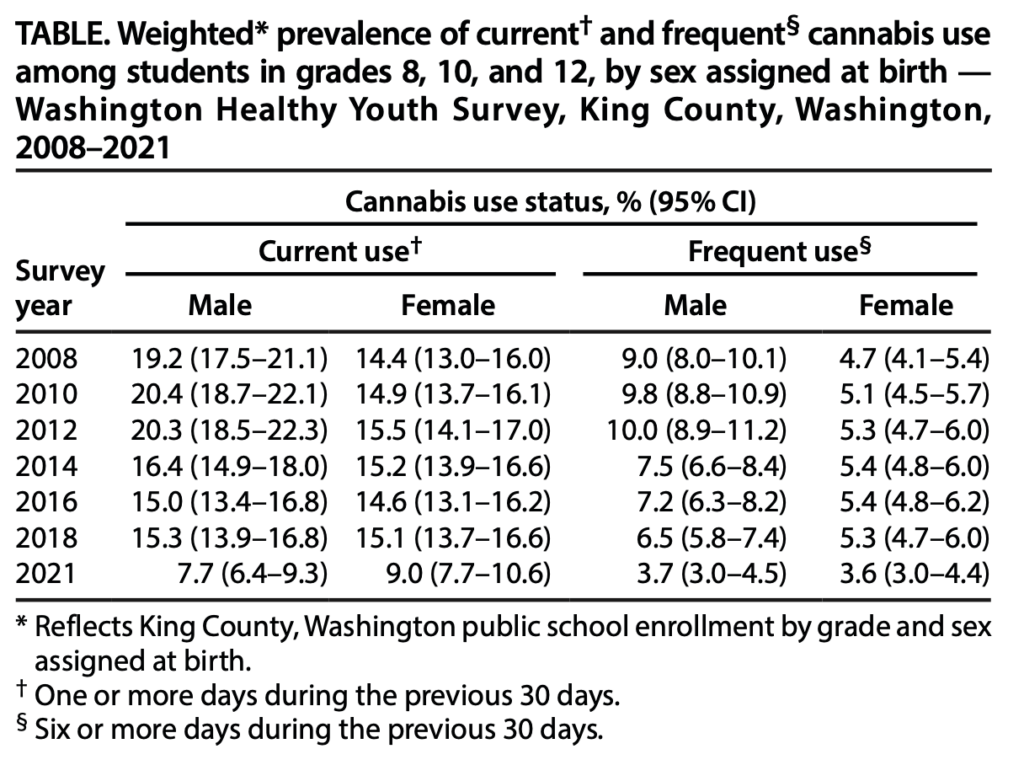
Centers for Disease Control and Prevention (CDC)
While the trend of lower teen use rates began shortly after legalization in the state, study authors said the COVID-19 outbreak, which led to stay-at-home orders beginning in March 2020, may have exaggerated the decline more recently.
“With increased time spent at home, students might have been subject to increased parental supervision, which could deter substance use, including use of cannabis,” the report says. “Increased parental supervision could have been compounded by limited access to cannabis, if a main source was from friends or social settings away from the home.”
Since peaking around 2010 and 2012, youth use has more or less steadily fallen, survey results indicate. Frequent use among males, for example, fell to 7.5 percent in 2014, to 7.2 percent in 2016, to 6.5 percent in 2018 and to 3.7 percent in 2021.
Use by female students has dropped as well, albeit less precipitously. After a local peak in 2012 of 15.5 percent current use, reported rates were 15.2 percent in 2014, 14.6 percent in 2016, 15.1 percent in 2018 and 9.0 percent in 2021.
Notably, 2021 was the first and only year of survey data that showed a higher prevalence of current use among female respondents, though males were still slightly more likely to report frequent use.
What were once striking differences in marijuana use prevalence rates between males and females has nearly disappeared in recent years, the CDC study found.
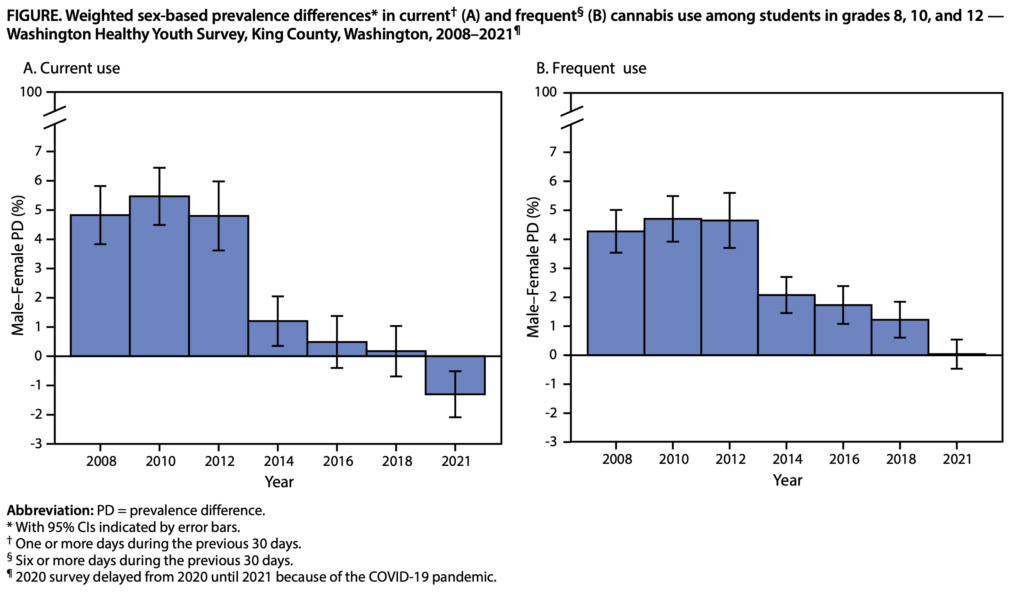
Centers for Disease Control and Prevention (CDC)
Past research has indicated that cannabis use among young people has generally declined amid the state-level legalization, authors Precious Esie of CDC and Myduc Ta of Public Health—Seattle and King County wrote, but “less is known about sex-specific trends.”
While the report speculated that the differences in cannabis use by sex could be related to evolving social norms around marijuana, they encouraged future studies to “examine trends in cannabis use norms by sex, and the association between norms and cannabis use by sex.”
“Although downward trends in cannabis use among King County students in grades 8, 10, and 12 are encouraging,” researchers concluded, “continued monitoring is necessary to better understand longer-term effects of social phenomena, including cannabis legalization and pandemic-related disruptions, and to assess whether observed decreases are sustained. It is important for monitoring to prioritize identifying differences across demographic characteristics, including sex or gender identity, which can potentially support the development of tailored interventions and ensure equity in programmatic cannabis use reduction and prevention measures.”
The findings come shortly after a separate study of Canadian high school students found that the proportion of youth who said marijuana was easy to access fell after legalization—a phenomenon authors of that study attributed to Canada’s national legalization of marijuana as well as COVID-related social distancing.
Last month, meanwhile, a U.S. health official said that teen marijuana use has not increased “even as state legalization has proliferated across the country.”
“There have been no substantial increases at all,” said Marsha Lopez, chief of the National Institute on Drug Abuse’s (NIDA) epidemiological research branch. “In fact, they have not reported an increase in perceived availability either, which is kind of interesting.”
A separate, earlier analysis from CDC found that rates of current and lifetime cannabis use among high school students have continued to drop amid the legalization movement.
A study of high school students in Massachusetts that was published last November found that youth in that state were no more likely to use marijuana after legalization, though more students perceived their parents as cannabis consumers after the policy change.
A separate NIDA-funded study published in the American Journal of Preventive Medicine in 2022 also found that state-level cannabis legalization was not associated with increased youth use.
The study demonstrated that “youth who spent more of their adolescence under legalization were no more or less likely to have used cannabis at age 15 years than adolescents who spent little or no time under legalization.”
Yet another 2022 study from Michigan State University researchers, published in the journal PLOS One, found that “cannabis retail sales might be followed by the increased occurrence of cannabis onsets for older adults” in legal states, “but not for underage persons who cannot buy cannabis products in a retail outlet.”
The trends were observed despite adult use of marijuana and certain psychedelics reaching “historic highs” in 2022, according to separate data released last year.
A Gallup poll from last summer, meanwhile, found that fully half of all American adults have tried marijuana at some point in their lives, with rates of active cannabis consumption surpassing that of tobacco. Broken down by age, 29 percent of those 18–34 said they currently smoke marijuana, though that’s not necessarily representative of overall cannabis use, because the survey only asked about smoking and not other modes of consumption such as edibles, vaping or tinctures.
Washington Lawmakers Hear Multiple Marijuana Bills, Including On Home Cultivation And THC Limits



